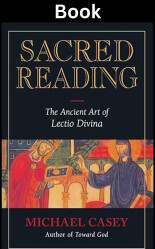There are various ways to use the Bible, and one of my favorites is in prayer. If you want to Learn How to Read and Understand the Bible, there are a few basic tips to get you started. Like any ancient manuscript or text, we can study the historical details and the culture of the Bible. If you want to go one step deeper and are looking for the right concordances, Bible handbook, commentaries, and surveys to help you, Resources to Read, Understand, and Study the Bible might point you in the right direction.
Sacred Reading – “Lectio Divina”
A third method is to read meditatively so that the meaning of the words help us encounter the presence of God prayerfully through the text. By reading the Bible meditatively the text becomes a gateway to experiencing God’s presence. There is a time-tested practice that extends back to the early church: it is called Sacred Reading, or Lectio Divina, in Latin. Here are the four steps in the meditative journey.
Step 1: Reading
Select a passage of Scripture that the Lord might be leading you to meditate on. This passage should be a verse or two and no more than a paragraph. Read it out loud to yourself, slowly. Listen to it as if God himself were speaking the words to you. Basil Pennington writes, “It may be the lips of another…that now pronounce the words, but it is God who speaks them…making himself present, as any lover might, by communicating his love” (Pennington, Lectio Divina, 4).
Step 2: Meditation
This step requires slowing down and pondering. What does it really mean, and what is God showing me through this?Go over the words in your mind and digest what they mean, rereading phrases again and again, stopping at certain words and allowing the meaning to sink deep into you. Pay attention to one specific word or phrase that seems to grab your attention. How does God want to meet you in that phrase? You aren’t just trying to know information, you are attempting to participate in God through this truth.
Don’t rush it. The goal is to soak in a specific truth that God is highlighting to you. This stage of the process may take two to five minutes. As you grow in your ability to focus or still yourself you may try to spend a longer period of reflection, like ten or fifteen minutes.
Step 3: Prayer
In this stage of the journey the scripture text turns into a prayer to God. Use the words and phrases that you find in the text as a prayer. Maybe it will become a thanksgiving prayer for something God has done. Or maybe it will become a request for something that I need God to provide like his comfort, protection, or sense nearness. During this step the text serves as a doorway to meet with God. Now that we are in God’s presence we can practice relating and communicating to God.
Step 4: Contemplation
Contemplation is going back to the truth again and again. This usually happens throughout your day. A practical habit might be to jot down that phrase or verse in your phone, or on an index card and keep it somewhere you will see throughout the day. The idea is to keep returning to that truth in your mind and allowing it to soak ever deeper into your heart and spirit. Consider that your manna for the day. It is carrying the life of God’s nourishing presence into your daily routine.
Conclusion:
You can practice this prayer journey on your own or in a group. It’s a simple way to transition from being stuck in “study mode” to encountering God. Here are two book resources that you might find helpful in growing deeper in this prayer path. Enjoy your journey into experiencing God through his Word.


Tags: church, prayer, scripture, word, presence, conversation, meditation, god's voice, contemplation